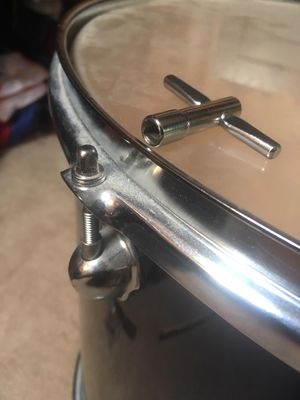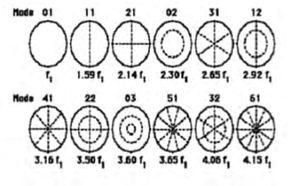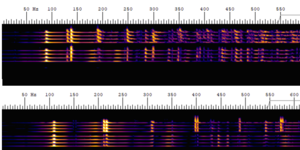User:JosephStewart
The Tom Tom is a snareless drum with two tensioned drum heads, one of the common drums used in a drum kit. They range in size, commonly from 6 to 24 inches in diameter, with the largest toms (floor toms) having the deepest sound, while the smaller ones (set up on a rack) have higher sounds. Since being added to the drum kit in the early 1900s, the Tom Toms are responsible for the majority of notes in drum fills and solos.
History of the Tom Toms
The Tom Toms of today are descended from the Chinese tom tom, which were commonly 8-14 inches in diameter and a few inches in depth, consisting only of a wooden shell and two drum heads stretched over the top and bottom of the drum. In the 1920's, American drum companies began importing these drums, and manufacturing new Tom Toms that were deeper and designed to be in multi tom setups, mounted on racks. They were also modified with tension rods on the top drum head, allowing the drum to better hold its tune. In the early 1930's, Jazz musician Gene Krupa signed on with Slingerland Drum Company in order to develop the tom toms further, giving them fully tuneable top and bottom heads. This became the standard in tom tom production. Further evolution occured in the 1960s, when concert toms, which have a single head, were used in order to lessen the unwanted reverberation that was present in early recording technology. Some musicians, however, such as Led Zepplin's John Bonham, who continued to use the traditional double headed tom toms.
Construction
The main components of the tom tom are the shell, drum hardware (which includes parts like the tension rods and rims), and the drum head. The shells typically vary in size from 6 inches diameter up to 24 inches diameter, and can be made with wood (commonly birch, although multi ply woods are used as well), as well as materials like fiberglass. The toms' shells are often stylized to different colours and designs by laminating them in plastic, giving them a recognizable shiny finish.
The drum head, or skin as it is sometimes called, due to the fact they were originally made up of stretched animals skins, is the membrane that is stretched over the ends of the drum. Regular toms have two drum heads, one over the top and one over the bottom of the drum, but there are also concert toms, which only have a head over the top of the drum. The head is responsible for creating the vibrations that resonate within the drum, and as such the tension and intensity with which the head is struck can greatly influence the sound produced. Today, tom tom drum heads are synthetically made out of plastic.
The drum head can be tightened or loosened via the tension rods, which are easily adjusted with a drum key. The tension rods, which surround the drum head, are attached to the drum head through threaded lugs at the edge of the head, and give the drummer the ability to easily tune the drum via a drum key. The tension rods are also responsible for holding the metal rim of the drum onto the shell, which in turn holds down the drum head.
Acoustics
The tom toms sound is highly dependent on the tuning and also where the drum is struck, as well as the width of the drum. Wider tom toms, such as the floor tom, produce a lower frequency sound, while tom toms that are less wide produce higher frequency sounds. Drum kits consist of tom toms of varying widths to allow drummers to produce sounds at a variety of pitches. In addition to the width, where the drum is struck also will influence different vibration modes, and will cause the drum to resonate at different frequencies and produce a variety of sounds, from deep thuds, to brighter more musical tones. The tension of the drum head is also important to the sound of the drum. Higher tension of the drum head results in a higher frequency of sound produced, but at lower amplitudes. Lower tensions will create the opposite, lower frequency sounds that has higher amplitude. Together, these factors allow for great variability in the acoustics of the tom toms.
Frequency Spectra
The tom toms frequency spectra is influenced by both tension of the drum head, and the location of the strike upon the drum head. Figure 3 shows the difference between a tightly tuned floor tom and a loosely tuned one. Tightening the drum head reduces unwanted vibration, resulting in a much crisper sound with less reverberation. A very loose drum head vibrates for longer after striking the drum, resulting in a less crisp sound.
Figure 3 also shows the different frequencies that are most excited when striking halfway between the edge and center of the drum (the first four frequency spectra), vs striking in the center of the drum (next four frequency spectra). By striking in the center of the drum, the 01 mode of the membrane is excited. This produces a low thumping sound that quickly dissipates as it is very effective at radiating its energy to the surrounding air. The 11 mode vibrates at 1.59 times the frequency of the 01 mode, visible in the loose tom in figure 3. The 21 mode, which is most excited when the drum is struck between the center and the edge, vibrates with a frequency 2.135 times the 01 mode. These 11 and 21 modes vibrate for longer than the 01 mode, and as such are responsible for more of the musical quality of the tom toms.
References
https://reverb.com/news/origins-of-the-drum-set-part-I-the-evolution-of-the-tom



